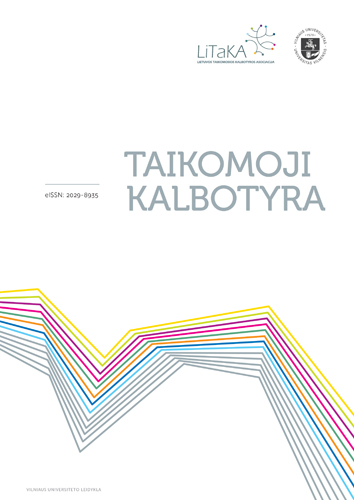Sociokultūrinių vakarų aukštaičių kauniškių ir rytų aukštaičių panevėžiškių tinklų tyrimas
Research of socio-cultural network of Western Aukštaitians of Kaunas and Eastern Aukštaitians of Panevėžys
Author(s): Agnė ČepaitienėSubject(s): Applied Linguistics
Published by: Vilniaus Universiteto Leidykla
Keywords: socio-cultural network; Western Aukštaitians of Kaunas; Eastern Aukštaitians of Panevėžys; vitality of ALL points; change of dialects;
Summary/Abstract: The article is based on a universal social network theory. It also offers a socio-cultural network of two subdialect areas: Western Aukštaitians of Kaunas and Eastern Aukštaitians of Panevėžys. The paper attempts to investigate migration directions of residents of the inhabited areas included into the Atlas of Lithuanian Language (ALL points). They are used to identify hypothetical zones of ALL points demonstrating a high degree of subdialect vitality.The research material consists of statistical data of 176 ALL points (121 of Western Aukštaitians of Kaunas and 86 of Eastern Aukštaitians of Panevėžys) collected in 2011–2015. The data is summarized in a table. The paper also includes a socio-cultural network completed with the help of the software Paint referring to 6 criteria: movement directions (to schools, hospitals, libraries, churches, post offices and supermarkets) of the communities’ members residing in the ALL points and covering dialectal areas of Western Aukštaitians of Kaunas and Eastern Aukštaitians of Panevėžys. The paper evaluates the viability, social structure, communicative networks of situations and possible directions of dialectal changes of ALL points.The results show that both subdialects are linguistically similar in strength; both demonstrate high vitality. Dialectal features seem to be best maintained in and around Ariogala, Jùrbarkas, Šakiai, Kazlų Rūdà, Vilkaviškis, Kalvarijà and Biržai, Pasvalỹs, Radviliškis, Ramygala.Subdialect changes have been mainly determined by a high degree of mobility within the dialectal areas rather than the impact of other dialects. Internal migration is stimulated by attractive supermarkets and medical institutions in the nearest ALL points, while migration to other areas of subdialects is motivated by attractive supermarkets (in case of Western Aukštaitians of Kaunas) or a lack of educational institutions in the original places of residence (in case of Eastern Aukštaitians of Panevėžys).A possible direction of changing dialectal features is the south in case of Western Aukštaitians of Kaunas and the west in case of Eastern Aukštaitians of Panevėžys. However, the opposite direction is not excluded: dialectal features of Western Aukštaitians of Kaunas are actively penetrating the dialectal area of Southern Aukštaitians and dialectal features of Eastern Aukštaitians of Panevėžys tend to spread in the dialectal area of Western Aukštaitians of Šiauliai.Presumably, the above indicators show that despite similarities and differences between both subdialects and the standard language, the subdialects have similar conditions to survive and become stronger.
Journal: Taikomoji kalbotyra
- Issue Year: 2016
- Issue No: 8
- Page Range: 136-159
- Page Count: 24
- Language: Lithuanian

